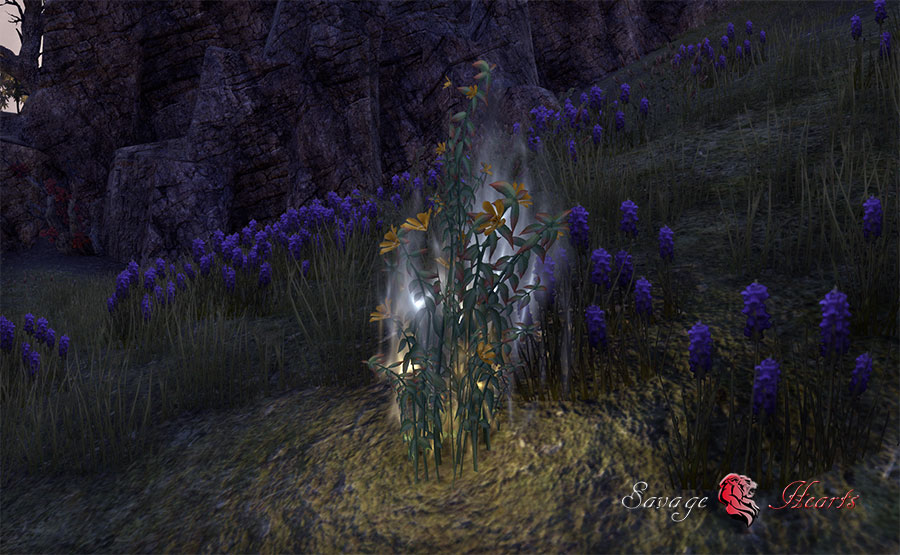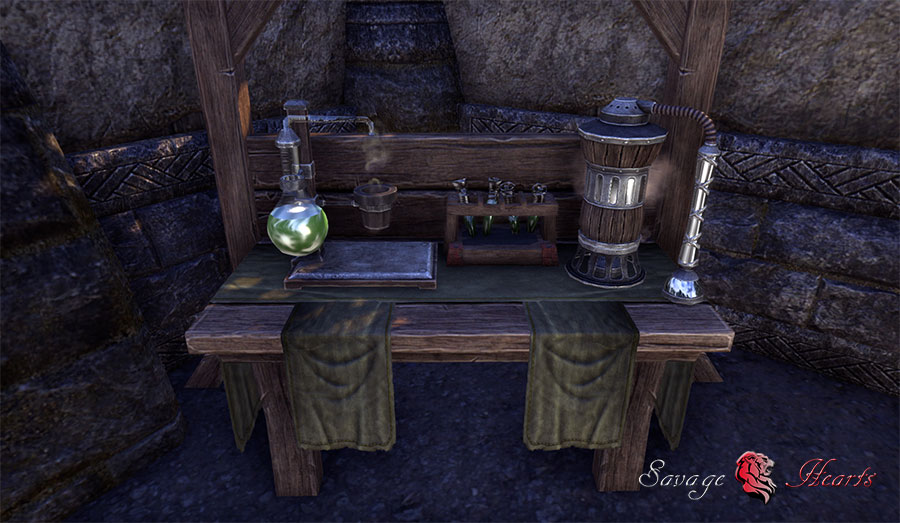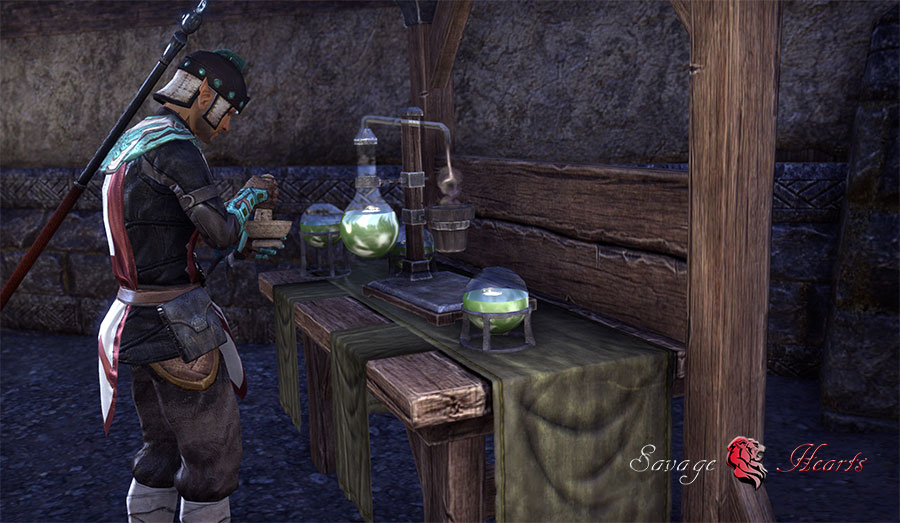Alchemy is used for creating beneficial consumable items and potions. They can increase how long positive effects last, replenish stats and provide your character with abilities that it might not have had before (for example, an increase in invisibility detection).
Potions provide a rapid bonus burst and complement the longer term Provisioning buffs very well to provide tactical and precise battlefield applications. Some of the potions do have some negative side effects also, so when mixing you do need to be careful.
Very High Profitability
Gathering

The Current List of Reagents
- Blessed Thistle (leafy)
- Blue Entoloma (fungal)
- Bugloss (leafy)
- Columbine (leafy)
- Corn Flower (leafy)
- Dragonthorn (leafy
- Emetic Russula (fungal)
- Imp Stool (fungal)
- Lady’s Smock (leafy)
- Luminous Russula (fungal)
- Mountain Flower (leafy)
- Namira’s Rot (fungal)
- Nirnroot (leafy)
- Stinkhorn (fungal)
- Violet Coprinus (fungal)
- Water Hyacinth (leafy)
- White Cap (fungal)
- Wormwood (leafy)
Alchemy Plant Properties List #1
| Restores Health | Restores Stamina | Restores Magicka | Increases Armor | Increases Spell Resistant | Unstoppable (Immune to CC) | Increases Weapon Power | Increases Spell Power | |
| Blessesed Thistle | X | X | ||||||
| Blue Entoloma | X | |||||||
| Bugloss | X | X | X | |||||
| Columbine | X | X | X | X | ||||
| Corn Flower | X | X | ||||||
| Dragonthorn | X | X | ||||||
| Emetic Russula | ||||||||
| Imp Stool | X | |||||||
| Lady’s Smock | X | X | ||||||
| Luminous Russula | X | |||||||
| Mountain Flower | X | X | X | |||||
| Namira’s Rot | X | |||||||
| Nirnroot | ||||||||
| Stinkhorn | X | |||||||
| Violet Coprinus | X | |||||||
| Water Hyacinth | X | |||||||
| White Cap | X | |||||||
| Wormwood | X |
Alchemy Plant Properties List #2
| Increases Weapon Critical | Increases Spell Critical | Detection | Speed | Invisibility | Ravage Health | Ravage Stamina | Ravage Magical | |
| Blessesed Thistle | X | X | ||||||
| Blue Entoloma | X | X | ||||||
| Bugloss | ||||||||
| Columbine | ||||||||
| Corn Flower | X | X | ||||||
| Dragonthorn | X | |||||||
| Emetic Russula | X | X | X | |||||
| Imp Stool | ||||||||
| Lady’s Smock | X | |||||||
| Luminous Russula | X | |||||||
| Mountain Flower | ||||||||
| Namira’s Rot | X | X | X | |||||
| Nirnroot | X | X | ||||||
| Stinkhorn | X | X | ||||||
| Violet Coprinus | X | X | ||||||
| Water Hyacinth | X | X | ||||||
| White Cap | X | |||||||
| Wormwood | X | X |
Alchemy Plant Properties List #3
| Lower Weapon Power | Lower Spell Power | Lower Weapon Critical | Lower Spell Critical | Lower Armor | Lower Spell Resistance | Stun | Lower Run Speed | |
| Blessesed Thistle | ||||||||
| Blue Entoloma | X | |||||||
| Bugloss | X | |||||||
| Columbine | ||||||||
| Corn Flower | ||||||||
| Dragonthorn | X | |||||||
| Emetic Russula | X | |||||||
| Imp Stool | X | X | ||||||
| Lady’s Smock | X | |||||||
| Luminous Russula | X | X | ||||||
| Mountain Flower | X | |||||||
| Namira’s Rot | ||||||||
| Nirnroot | X | X | ||||||
| Stinkhorn | X | |||||||
| Violet Coprinus | X | |||||||
| Water Hyacinth | X | |||||||
| White Cap | X | X | ||||||
| Wormwood | X |
The current list of water (in order of alchemy level)
- Natural Water
- Clear Water
- Pristine Water
- Cleansed Water
- Filtered Water
- Purified Water
- Cloud Mist
Locating A Station
You can find Alchemy Stations in cities and towns that are identified using a plant-like symbol on the map and on flags on the outside part of the station.
The station looks like a wooden bench with empty vials needing to be filled, potions brewing and liquids separating. To access the crafting interface you just need to walk to the station and then press on the interact key.

Creating Potions
Discovery
As you start mixing solvents and reagents together, the potions that are successfully crafted will yield each of the reagant’s properties, and they will be recorded in the crafting interface. Every reagent might have as many as four properties that can be combined for different effects.
Below you will find the compiled a list of working potions that can be used to level. Keep in mind, that when you are leveling (unless you prefer specific potions), the same reagents can be used in all of your potions. What really matters is the waters.
List of working potions that can be used to level
| Potion Name | Effect | Reagent #1 | Reagent #2 |
| Elixir of Health | Restore Health Immediately and Overtime, Restore Magicka Immediately and Over time. | Bugloss | Columbine |
| Elixir of Health | Restore Health Immediately and Overtime, Restore Stamina Immediately and Over time. | Mountain Flower | Columbine |
| Elixir of Detection | Increase Stealth Detection 24 meters (10 sec) | Corn Flower | Wormwood |
| Elixir of Invisible | Vanish (3 sec) | Blue Entoloma | Namira’s Rot |
| Elixir of Weapon Power | Increase Weapon Damage (10 sec), Restore Stamina Immediately and Over time. | Blessed Thistle | Dragonthorn |
| Elixir of Spell Power | Increase Spell Damage (10 sec), Restore Magicka Immediately and Over time. | Corn Flower | Lady’s Smock |
| Elixir of Weapon Critical | Increase Weapon Critical (10 sec) | Dragonthorn | Wormwood |
| Elixir of Spell Critical | Increase Spell Critical (10 sec) | Lady’s Smock | Namira’s Rot |
| Elixir of Unstoppable | Become Immune to Knockback and Disabling effects (3 sec) | Columbine | Namira’s Rot |
| Elixir of Speed | Increase Movement Speed by 31% (10 sec) | Blessed Thistle | Namira’s Rot |
Skills
Solvent Proficient is one of the Alchemy skills that you can put points in for enhancing the craft. It is the only skill that is required in order to raise alchemy to its maximum level. That being said, there are numerous other skills that can be used for enhancing and improving the profession.
There isn’t any “Best Order” for the skills really for allocating to alchemy like there are with the armor professions. For gathering, Keen Eye is quite important. I recommend that you focus there to start.
Solvent Proficiency
- Rank 1: Allows the Alchemist to use Natural Water to make level 3 potions and Clear Water to make level 10 potions.
- Rank 2: Allows the Alchemist to use Pristine Water to make level 20 potions.
- Rank 3: Allows the Alchemist to use Cleansed Water to make level 30 potions.
- Rank 4: Allows the Alchemist to use Filtered Water to make level 40 potions.
- Rank 5: Allows the Alchemist to use Purified Water to make level CP 10 potions.
- Rank 6: Allows the Alchemist to use Cloud Mist to make level CP 50 potions.
Keen Eye
- Rank 1: Reagents in the world will be easier to see when you are 20 meters or closer.
- Rank 2: Reagents in the world will be easier to see when you are 30 meters or closer.
- Rank 3: Reagents in the world will be easier to see when you are 40 meters or closer.
Medicinal Use
- Rank 1: When using potions, resulting effects last 10% longer.
- Rank 2: When using potions, resulting effects last 20% longer.
- Rank 3: When using potions, resulting effects last 30% longer.
Chemistry
- Rank 1: Produces 1 extra potion per crafting attempt.
- Rank 2: Produces 2 extra potion per crafting attempt.
- Rank 3: Produces 3 extra potion per crafting attempt.
Laboratory Use
- Rank 1: Allows the use of up to 3 Reagents while mixing Potions.
Snakeblood
- Rank 1: Reduces negative effects in potions by 50%.
- Rank 2: Reduces negative effects in potions by 80%.
- Rank 3: Reduces negative effects in potions by 100%.
- Eat Your Reagents- Using reagents from inventory (eating) will enable you to uncover that reagent’s first trait and gain inspiration. It is only necessary for you to eat one of them.
- Discover ALL traits- When you discover traits you gain insight about the potions you are going to make, and it also provides you with quite a lot of experience. This should be done before you spam-manufacture the same potion repeatedly for leveling.
- Keep making the same potions- When you are leveling, when you are searching for inspiration, two of the same reagent plants level you from 1-50. These can be found in the lower level zone. Upgrading your waters is all you have to do.
- Gather at Night- When you have an opportunity to gather at night and your Keen Eye ability is all set, you’ll be able to see the reagent plants from great distances. In the dark, it is quite bright.

Seriously amazing guide I’ve used it so many times already. Luminous Russula also ravages Stamina. Thanks for putting all of this in one place!
Thank you, and thank you for pointing out the Luminous Russula, it has been updated.
I have to agree with deliciousaids I have been crafting alchemy for a while now and this guide is quite comprehensive , where should I post extra properties to up date the list , happy hunting
Just do it here in comments, unless you have more then 500 words then submit your own article here https://www.savagehearts.us/publish-your-article/
Using Namia’s rot for skill up potions should be avoided, as this is one of the reagents that people will pay money for.
Columbine, Bugloss, and Mountain flower are the 3 flowers used to make tripots of health magicka and stamina. Lady’s Smock, Corn Flower and Water Hyacinth are the 3 used for tripots of magicka spell power and spell crit. try not to use those for leveling since they are infact valuable :3
Another good recipe I wanted to share with the guild is a useful potion I like for my stam-based nightblade:
Dragonthorn, Mountain Flower, and Water Hyacinth will give you increased Weapon Crit, Restore Health and Restore Stamina. The ingredients are relatively cheap/easy to find.
What good potions can be made using some of the negative effects? Maybe because my toons have been magic based I’ve usually just make the two potion Argarius86 mentioned above. Maybe something with invisible thrown in, but usually not.
I find the potion maker addon handy for uncovering all the traits. This will prevent you from wasting raw materials, because every potion works.
“What good potions can be made using some of the negative effects?” From what I have seen there is no reason to make potions with negative side effects except the following: 1. simply making potions to gain experience in alchemy. 2. combining reagents with negative effects to try and discover other traits in common. 3. completing the daily crafting writ which will occasionally ask for negative effect potions. Unlike some other Elder Scrolls games, negative effect potions cannot be used offensively as weapon poisons in ESO. If you are not crafting negative effect potions for the crafting writs then I… Read more »